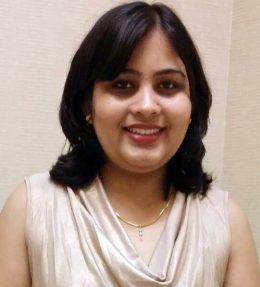
Swati Padhee, a computer science Ph.D. student, interned with the National Board of Medical Examiners this summer.
Using language data to help support the validity of test scores on medical licensing exams was the goal of Wright State University computer science Ph.D. student Swati Padhee.
The work came during her summer internship with the National Board of Medical Examiners, a nonprofit that develops and manages assessments of health care professionals.
Padhee’s project examined the use of natural language processing to explore conscious and unconscious language patterns used by item writers in the licensing exams. Natural language processing uses linguistics, computer science and artificial intelligence to program computers to process and analyze large amounts of language data.
“My findings may guide the development of methods to address intentional or unintentional stereotypical language patterns found in test items, thereby improving the evidence to support the validity of the test scores,” Padhee said.
Founded in 1915, the National Board of Medical Examiners is known for its role in developing the United States Medical Licensing Examination. The exam for medical students and residents helps determine qualifications to grant medical licenses.
Padhee said she was excited by the mission of the board to protect the health of the public through state-of-the-art assessment of health professionals.
“This opportunity came to me at a time when we were almost more than one year into a global pandemic,” she said. “While artificial intelligence is playing a critical role in multiple domains, exploring it for assessment science in medical education, which is the backbone of health care, attracted me the most.”
Padhee grew up in Sambalpur, India, and graduated from Kendriya Vidyalaya high school in Sambalpur in 2003, when she was in 10th grade. She was inspired to pursue engineering and computer science by the careers of her parents. Her father earned a degree in electrical engineering prior to pursuing law. Her mother holds master’s degrees in mathematics and physics.
Padhee earned her bachelor’s degree in electrical engineering from Biju Patnaik University of Technology and her master’s degree in electrical engineering from Veer Surendra Sai University of Technology, both degrees with a specialization in power system engineering. She then earned her master’s in computer science from Wright State.
“During my master’s, I worked on solving one of the biggest challenges in rural India — power blackouts,” she said.
Padhee designed a framework to model high-voltage power grid data that forecast tentative future blackouts.
“This work could be utilized to predict future blackouts and thereby reduce the load in that specific grid region to prevent it,” she said. “That is when I knew that I would find satisfaction in applying technology to solve real-world problems and joined computer science at Wright State to improve my skills.”
Padhee said she chose Wright State to pursue her Ph.D. because the university encourages applied research to solve impactful societal issues.
“Apart from an up-to-date course structure and syllabus, the university has a diverse group of theoretical and applied research professors who have their doors open always to brainstorm on open research problems,” she said. “And the openness of various departments to collaborate on interdisciplinary research puts Wright State at the forefront of applying artificial intelligence to address multiple societal causes.”
Tanvi Banerjee, Ph.D., associate professor of computer science and engineering and director of the Data Science for Healthcare research lab, said Padhee’s non-computer science background makes her unique.
“Despite a sharp learning curve, Swati embraces every challenge I throw at her and thrives on making it a success,” Banerjee said. “She is a go-getter in every sense of the term.”
Padhee said her internship with the National Board of Medical Examiners sharpened her desire to continue to do research following graduation.
“This internship has made me more passionate than ever to pursue a career in interdisciplinary, impactful research, and I feel better equipped to address various open real-world research problems using technology,” she said.

 Wright State’s annual Raidersgiving draws hundreds
Wright State’s annual Raidersgiving draws hundreds  Wright State named a Best for Vets College
Wright State named a Best for Vets College  Wright State’s Boonshoft School of Medicine receives full continuing accreditation from Liaison Committee on Medical Education
Wright State’s Boonshoft School of Medicine receives full continuing accreditation from Liaison Committee on Medical Education  Wright State supports deaf and hard of hearing community with Deaf Festival
Wright State supports deaf and hard of hearing community with Deaf Festival  Wright State students showcase scientific discoveries at annual research festival
Wright State students showcase scientific discoveries at annual research festival 